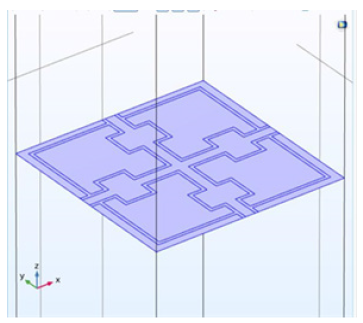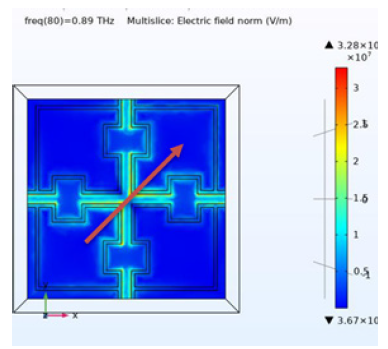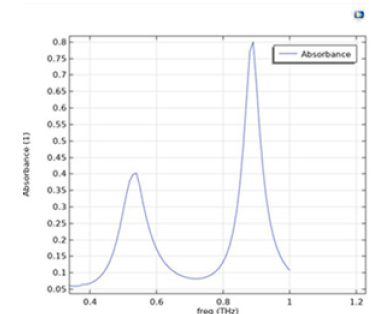- Submissions

Full Text
COJ Electronics & Communications
Metamaterial with Absorbance in Terahertz Frequency Range
Prutha Kulkarni*, Archana Ratnaparkhi and Shubham Kumar
Department of Electronics and Telecommunication, Vishwakarma Institute of Information Technology, India
*Corresponding author: Prutha Kulkarni, Department of Electronics and Telecommunication, Vishwakarma Institute of Information Technology, Pune, India
Submission: June 15, 2022;Published: November 02, 2022

ISSN 2640-9739Volume2 Issue4
Abstract
With the technological advancement we are exhausting different frequency bands in such a time metamaterial absorber which works in terahertz frequency band opens up the new avenue to look in. We can use this for the development of 6G technology and a lot of other applications. In contrast to the current situation where megahertz bandwidth is sufficient to drive audio and video components for user applications, future 2030s networks will require bandwidth at several gigahertz (GHz) (from tens of gigahertz to 1 terahertz [THz]) to function properly. Based on the current radiofrequency distribution chart, it is not possible to detect such a wide radio spectrum below 90GHz (0.09THz). Interestingly, these interlocking radio spectrum blocks are readily available at higher electrical spectrum, especially in the Terahertz (THz) frequency band [1-5].
Keywords: Metamaterial; Absorption; Substrate; Periodicity
Introduction
The metamaterial is a special designed man-made substance that exhibits properties that we don’t find naturally, for example, negative index. Metamaterial works on the principle of an LC circuit where we can vary the inductance and capacitance of the circuit to achieve different resonance frequencies. Resonance frequency also depends upon the periodicity and thickness of the substrate used. The metamaterial can be used as an absorber as it absorbs the EM wave of particular frequencies at the resonance. Here we tried to design the metamaterial with a resonance frequency between 0.1THz to 1THz. We have used Kapton as substrate with thickness 0.3mm and 5um as width and length. Kapton has a refractive index μ =1.88 + 0.04j.
To calculate the absorptivity percentage, we can use the following relation between reflection coefficient, transmission coefficient and absorptivity [6-8]
Absorptivity in % = (1 - abs(S11)2 - abs(S21)2
here S11 and S21 are reflection and transmission coefficients. Here S21 is 0 as we have covered the bottom layer with perfect electric conductor, hence we can use the following formula,
Absorptivity in % = (1 - abs(S11)2) × 100
Design, Simulations and Result
Now let’s see the design for our metamaterial. We have used COMSOL for design and simulation. The whole thing is made up of two blocks, one of air and another of our substrate (Figure 1 & 2).
Figure 1: The dimensions for the substrate are as follow: Width=length=0.03mm Thickness= 0.2mm

Figure 2: The actual design here: W=0.5um H=3.5um A1=5um A2= 6.5um

The material used here is PEC/gold fabricated on the Kapton substrate of 0.2mm. The thickness of the air domain is 0.4mm [9-11]. And we have applied the perfect electric condition on the bottom layer and on design so that the incident wave cannot be transmitted (Figure 3-5).
Figure 3:

Figure 4:

Figure 5:

Along with a metamaterial structure, different boundary conditions need to be applied to the blocks, in order to have the required periodicity and electromagnetic condition.
We need to initialize the refractive index of the substrate as μ =1.88 + 0.04j.
Once every condition is set, we can start the simulation (Figure 6).
In Figure 7 we have plotted absorbance along the Y axis and frequency along the x axis in terahertz. We are getting three peaks which shows multiple resonance frequency but at 0.89THz (Figure 8) we are getting the maximum peak around 80% absorbance [11- 13]
Figure 6:

We can see clearly how the Electric field is trapped between the parallel plate structure. The range for this experiment is kept between 0.1THz to 1THz. We have applied the electric field of 1V/m in both x and y directions hence the resultant electric field is at 45 deg to x-axis. The arrow in Figure 6 show the direction of electric field and we can see that how there is electric is an electric field between the plates along the direction of arrow (Figure 7).
Figure 7:

In Figure 7 we have plotted absorbance along the Y axis and frequency along the x axis in terahertz. We are getting three peaks which shows multiple resonance frequency but at 0.89THz (Figure 8) we are getting the maximum peak around 80% absorbance [11- 13].
Figure 8:

Conclusion
We can conclude from the above result that our design shows good absorbance, and it further can be optimized to get much sharper results. In contrast to the current situation where megahertz bandwidth is sufficient to drive audio and video components for user applications, future 2030s networks will require bandwidth at several gigahertz (GHz) (from tens of gigahertz to 1 terahertz [THz]) to function properly. Based on the current radiofrequency distribution chart, it is not possible to detect such a wide radio spectrum below 90GHz (0.09THz). In such a scenario our work is a step toward developing metamaterials that help to solve this problem. New advances in different technologies have made the previously unused terahertz frequency band accessible for imaging systems [14]. The ‘Terahertz Gap’ has a frequency degree from ∼0.3 THz to ∼10THz in the electromagnetic spectrum which in among microwave and infrared. The terahertz radiations are invisible to naked eye & in assessment with X-ray they may be intrinsically safe, non-unfavorable and non-invasive. that is such a new subject that researchers round the arena race to build the primary sensible device [15]. It resolves many of the questions left unanswered via complementary strategies, such as optical imaging, Raman and infrared. Terahertz spectroscopy has quantity of packages run from detecting defects in tablet coating, product inspection (industry), spectroscopy (chemistry, astronomy), cloth characterization (physics), weapons concealed below garb (airports), detection of most cancers and caries. within the pharmaceutical industries it allows nondestructive, internal, chemical analysis of capsules, capsules and other dosage forms. This paper attempts therefore now not best to provide a short evaluation over the imaging era, but also over the complete variety of modern-day systems and studies in terahertz generation [16-20].
Acknowledgement
We would like to thank Mr. Ajinkya Punjal (Project Assistant, DCMPS TIFR Mumbai), Dr. Shriganesh Prabhu (Professor, DCMPS TIFR Mumbai) and Dr. Chardrashekhar Garde (Professor, Department of EAs, VIIT Pune) there regular support and contributions.
References
- Kshetrimayum RS (2004) A brief intro to metamaterials. IEEE potentials 23(5): 44-46.
- Capolino F (2017) Theory and phenomena of metamaterials. CRC Press, USA.
- Walser RM (2000) Metamaterials: What are they? what are they good for? APS March Meeting Abstracts, pp. Z5-001.
- Bukhari SS, Vardaxoglou JY, Whittow W (2019) A metasurfaces review: Definitions and applications. Applied Sciences 9(13): 727.
- Huang J (2017) Theory of LC circuit-based metamaterials. Journal of Nanophotonics 11(1): 016016.
- Sangala BR, Nagarajan A, Deshmukh P, Surdi H, Rana G, et al. (2020) Single and multiband thz metamaterial polarisers. Pramana, 94(1): 1-6.
- Chowdhury DR, Singh R, Reiten M, Chen HT, Taylor AJ, et al. (2011) A broadband planar terahertz metamaterial with nested structure. Optics express 19(17): 15817-15823.
- Tao H, Bingham C, Strikwerda A, Pilon D, Shrekenhamer D, et al. (2008) Highly flexible wide angle of incidence terahertz metamaterial absorber: Design, fabrication, and characterization. Physical Review B 78(24): 241103.
- Marwaha A, Rajni (2016) An accurate approach of mathematical modeling of SRR and SR for metamaterials. Journal of Engineering Science & Technology Review 9(6): 82-86.
- George B, Nair B, Menon SK (2018) Mathematical modeling and validation of a hexagonal split ring resonator. 2018 Second International Conference on Advances in Electronics, Computers and Communications (ICAECC). IEEE, pp. 1-4.
- Elander VE (2012) Mathematical modeling of metamaterials. 2011.
- Bose S, Ramaraj M, Raghavan S, Kumar S (2012) Mathematical modeling, equivalent circuit analysis and genetic algorithm optimization of an n-Sided Regular Polygon Split Ring Resonator (NRPSRR). Procedia Technology 6: 763-770.
- Valipour A, Kargozarfard MH, Rakhshi M, Yaghootian A, Sedighi HM (2021) Metamaterials and their applications: an overview. Proceedings of the Institution of Mechanical Engineers. Part L: Journal of Materials: Design and Applications, p. 1464420721995858.
- Rappaport TS, Xing Y, Kanhere O, Ju S, Madanayake A, et al. (2019) Wireless communications and applications above 100ghz: Opportunities and challenges for 6g and beyond. IEEE access 7(78): 729-78 757.
- Singh G, Marwaha A (2015) A review of metamaterials and its applications 19(6):
- Zhu W (2018) Electromagnetic metamaterial absorbers: From narrowband to broadband. Metamaterials and Metasurfaces. Intech Open London.
- Tanaka T (2017) Metamaterial absorbers and their applications. JSAP-OSA Joint Symposia. Optical Society of America p. 8a A409 4.
- Landy NI, Sajuyigbe S, Mock JJ, Smith DR, Padilla WJ (2008) Perfect metamaterial absorber. Physical review letters 100(20): 207402.
- Tao H, Landy NI, Bingham CM, Zhang X, Averitt RD, et al. (2008) A metamaterial absorber for the terahertz regime: design, fabrication and characterization. Optics express 16(10): 7181-7188.
- Landy N, Bingham C, Tyler T, Jokerst N, Smith D, et al. (2009) Design, theory, and measurement of a polarization-insensitive absorber for terahertz imaging. Physical Review B 79(12): 125104.
© 2022 Prutha Kulkarni. This is an open access article distributed under the terms of the Creative Commons Attribution License , which permits unrestricted use, distribution, and build upon your work non-commercially.
 a Creative Commons Attribution 4.0 International License. Based on a work at www.crimsonpublishers.com.
Best viewed in
a Creative Commons Attribution 4.0 International License. Based on a work at www.crimsonpublishers.com.
Best viewed in 







.jpg)






























 Editorial Board Registrations
Editorial Board Registrations Submit your Article
Submit your Article Refer a Friend
Refer a Friend Advertise With Us
Advertise With Us
.jpg)






.jpg)














.bmp)
.jpg)
.png)
.jpg)










.jpg)






.png)

.png)



.png)






